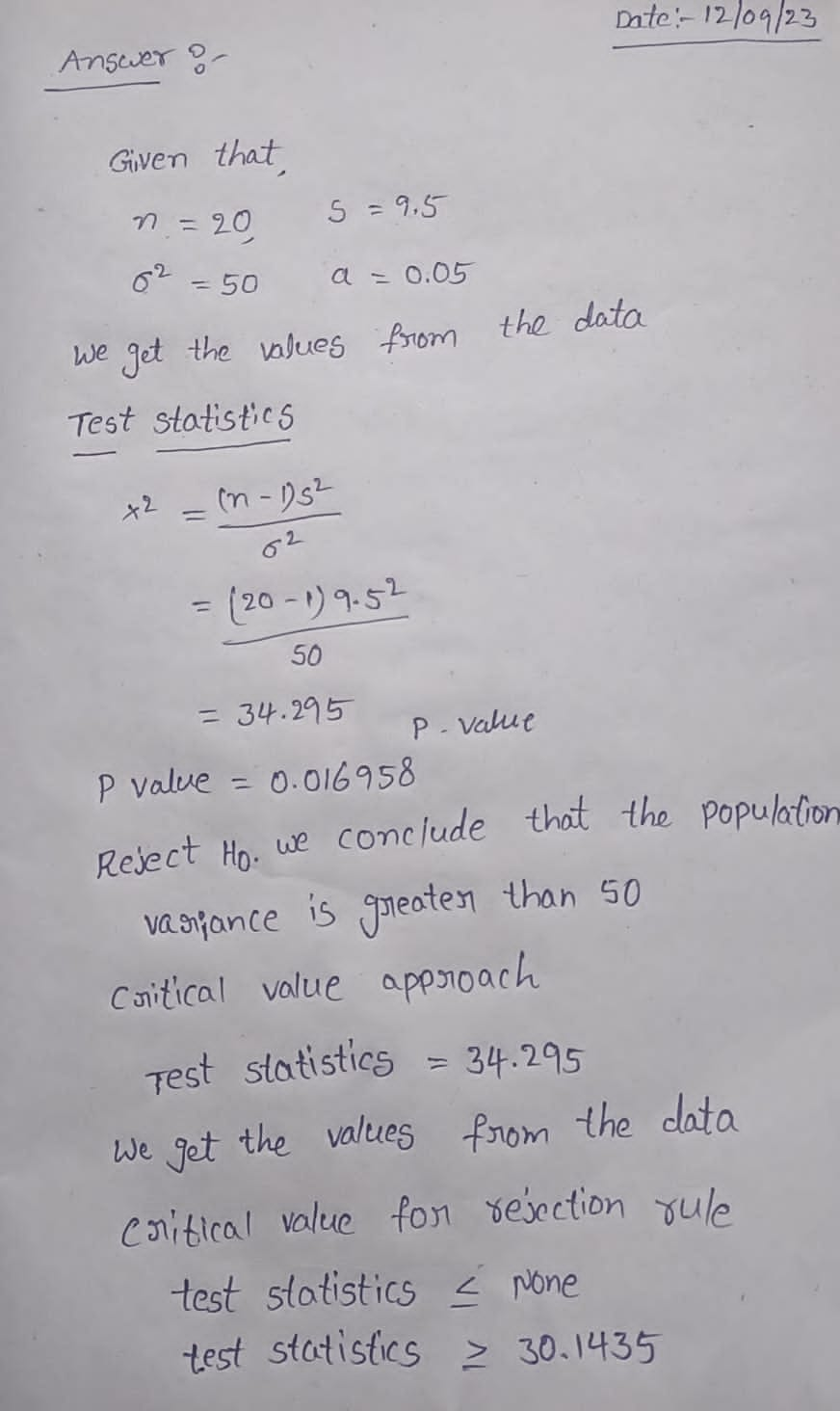You may need to use the appropriate technology to answer this question. A sample of 18 items provides a sample standard deviation of 9.5. Test the following hypotheses using a = 0.05. What is your conclusion? Ho: 0² ≤ 50 H₂:0² > 50 Use the p-value approach. Find the value of the test statistic. Find the p-value. (Round your answer to three decimal places.) p-value = State your conclusion. Reject Ho. We conclude that the population variance is greater than 50. Do not reject Ho. We conclude that the population variance is greater than 50. O Reject Ho. We conclude that the population variance is not greater than 50. O Do not reject Ho. We conclude that the population variance is not greater than 50. Use the critical value approach. Find the value of the test statistic. State the critical values for the rejection rule. (Round your answers to three decimal places. If the test is one-tailed, enter NONE for the unused tail.) test statistic S test statistic > State your conclusion. Reject Ho. We conclude that the population variance is greater than 50. Do not reject Ho. We conclude that the population variance is greater than 50. Reject Ho. We conclude that the population variance is not greater than 50. Do not reject Ho. We conclude that the population variance is not greater than 50.
You may need to use the appropriate technology to answer this question. A sample of 18 items provides a sample standard deviation of 9.5. Test the following hypotheses using a = 0.05. What is your conclusion? Ho: 0² ≤ 50 H₂:0² > 50 Use the p-value approach. Find the value of the test statistic. Find the p-value. (Round your answer to three decimal places.) p-value = State your conclusion. Reject Ho. We conclude that the population variance is greater than 50. Do not reject Ho. We conclude that the population variance is greater than 50. O Reject Ho. We conclude that the population variance is not greater than 50. O Do not reject Ho. We conclude that the population variance is not greater than 50. Use the critical value approach. Find the value of the test statistic. State the critical values for the rejection rule. (Round your answers to three decimal places. If the test is one-tailed, enter NONE for the unused tail.) test statistic S test statistic > State your conclusion. Reject Ho. We conclude that the population variance is greater than 50. Do not reject Ho. We conclude that the population variance is greater than 50. Reject Ho. We conclude that the population variance is not greater than 50. Do not reject Ho. We conclude that the population variance is not greater than 50.
MATLAB: An Introduction with Applications
6th Edition
ISBN:9781119256830
Author:Amos Gilat
Publisher:Amos Gilat
Chapter1: Starting With Matlab
Section: Chapter Questions
Problem 1P
Related questions
Question

Transcribed Image Text:You may need to use the appropriate technology to answer this question.
A sample of 18 items provides a sample standard deviation of 9.5. Test the following hypotheses using a = 0.05. What is your conclusion?
2
Ho: ≤ 50
H₂:0² > 50
Use the p-value approach.
Find the value of the test statistic.
Find the p-value. (Round your answer to three decimal places.)
p-value =
State your conclusion.
O Reject Ho. We conclude that the population variance is greater than 50.
O Do not reject Ho. We conclude that the population variance is greater than 50.
O Reject Ho. We conclude that the population variance is not greater than 50.
O Do not reject Ho. We conclude that the population variance is not greater than 50.
Use the critical value approach.
Find the value of the test statistic.
State the critical values for the rejection rule. (Round your answers to three decimal places. If the test is one-tailed, enter NONE for the unused tail.)
test statistic ≤
test statistic >
State your conclusion.
O Reject Ho. We conclude that the population variance is greater than 50.
O Do not reject Ho. We conclude that the population variance is greater than 50.
O Reject Ho. We conclude that the population variance is not greater than 50.
O Do not reject Ho. We conclude that the population variance is not greater than 50.
Expert Solution
Step 1: Test statistics > 30.1435

Trending now
This is a popular solution!
Step by step
Solved in 3 steps with 2 images

Similar questions
Recommended textbooks for you

MATLAB: An Introduction with Applications
Statistics
ISBN:
9781119256830
Author:
Amos Gilat
Publisher:
John Wiley & Sons Inc

Probability and Statistics for Engineering and th…
Statistics
ISBN:
9781305251809
Author:
Jay L. Devore
Publisher:
Cengage Learning

Statistics for The Behavioral Sciences (MindTap C…
Statistics
ISBN:
9781305504912
Author:
Frederick J Gravetter, Larry B. Wallnau
Publisher:
Cengage Learning

MATLAB: An Introduction with Applications
Statistics
ISBN:
9781119256830
Author:
Amos Gilat
Publisher:
John Wiley & Sons Inc

Probability and Statistics for Engineering and th…
Statistics
ISBN:
9781305251809
Author:
Jay L. Devore
Publisher:
Cengage Learning

Statistics for The Behavioral Sciences (MindTap C…
Statistics
ISBN:
9781305504912
Author:
Frederick J Gravetter, Larry B. Wallnau
Publisher:
Cengage Learning

Elementary Statistics: Picturing the World (7th E…
Statistics
ISBN:
9780134683416
Author:
Ron Larson, Betsy Farber
Publisher:
PEARSON

The Basic Practice of Statistics
Statistics
ISBN:
9781319042578
Author:
David S. Moore, William I. Notz, Michael A. Fligner
Publisher:
W. H. Freeman

Introduction to the Practice of Statistics
Statistics
ISBN:
9781319013387
Author:
David S. Moore, George P. McCabe, Bruce A. Craig
Publisher:
W. H. Freeman